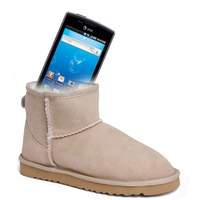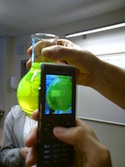 On my commute one morning recently, one of the local radio stations was discussing a ban on Ugg boots by a Philadelphia school district because students were hiding their cell phones in the calf-high versions and using them in class. The radio announcers were discussing how cell phones in the classroom are a distraction and that “real learning” doesn’t take place with a mobile device in hand. After listening to the announcers and various other callers lament the student use of cell phones in the classroom, I decided to call in and offer a different perspective.
On my commute one morning recently, one of the local radio stations was discussing a ban on Ugg boots by a Philadelphia school district because students were hiding their cell phones in the calf-high versions and using them in class. The radio announcers were discussing how cell phones in the classroom are a distraction and that “real learning” doesn’t take place with a mobile device in hand. After listening to the announcers and various other callers lament the student use of cell phones in the classroom, I decided to call in and offer a different perspective.
What did I say? Bring them on!
I am a proponent of BYOD (bring your own device) learning. I very rarely travel anywhere without my iPhone or iPad, and I can’t really blame my students if they do the same. I see the “addiction” students have to their cell phones as an opportunity to engage in learning since I view cell phones as another teaching tool, not a distraction.
Cellphones as a learning tool
In our classroom, we use our cell phones and other devices primarily in a literacy development fashion. I am a high school English teacher, and I find that many of my students feel more comfortable writing on their devices rather than using paper and a pen. From their devices, they can post their writing to our class blog for peer review and feedback.
 In terms of critical thinking, my students research extensively on the web and it is very convenient for them to pull out their phones to access our wireless network rather than going to a computer lab in the school. They can share the links to various sites via text messaging or Facebook in a timely and efficient manner. Many of my students communicate regularly in these mediums so it allows for the ubiquitous transmission of ideas into and out of the classroom.
In terms of critical thinking, my students research extensively on the web and it is very convenient for them to pull out their phones to access our wireless network rather than going to a computer lab in the school. They can share the links to various sites via text messaging or Facebook in a timely and efficient manner. Many of my students communicate regularly in these mediums so it allows for the ubiquitous transmission of ideas into and out of the classroom.
For the artists in my classroom, cell phones promote the expression of their thinking and learning. The students use the cameras on their phones to take photos for projects as well as to document the learning process for reflective writing pieces. Many students also use the cameras to take photos of our in-class work (anchor charts and exemplars) posted on the bulletin boards.
Cell phones and other devices also help my students to stay organized. The students in my class use the calendar apps in their phones and can also access my Google Calendar to keep track of important dates. From their devices, they can also visit my website which houses our tasks for the day and digital copies of class assignments.
Teaching good digital citizenship
 Finally, allowing cell phones in classrooms provides the opportunity to discuss proper cell phone etiquette as well as “netiquette.” One of my points when I called into the radio station was that I almost always have my cell phone out on my desk, and I model appropriate behavior for my students. Early in the semester, we have a class discussion about appropriate times to answer texts or emails. It’s a teachable moment that wouldn’t happen if my cell phone was tucked away in my bag.
Finally, allowing cell phones in classrooms provides the opportunity to discuss proper cell phone etiquette as well as “netiquette.” One of my points when I called into the radio station was that I almost always have my cell phone out on my desk, and I model appropriate behavior for my students. Early in the semester, we have a class discussion about appropriate times to answer texts or emails. It’s a teachable moment that wouldn’t happen if my cell phone was tucked away in my bag.
“Netiquette” is an especially important issue at the high school level. Our students will soon be attending post-secondary schools or joining the workforce. We discuss how having a positive online presence is important both for obtaining entrance into schools and receiving jobs. I often have students use their devices to “Google” themselves, and we use the results as a springboard for a discussion into what their online presence or “digital footprint” says about them. It has been a very eye-opening experience for many.
Pocket-Based Learning
As you can tell, I am a teacher who is passionate about providing students with opportunities to prepare for the next stages in their lives. I am also quite fortunate to work in a school system that values this principle as well. I am well supported in my endeavors to promote “Bring Your Own Device” pedagogy. As a system, we emphasize the need to be a “responsible digital citizen” and feel it’s important to promote positive character development in our schools.
I believe the ideals of ethical behavior and digital citizenship are the driving factors for BYOD. Our students are immersed in these wireless mediums, and it’s our responsibility as educators to help them learn how to use them responsibly. BYOD provides these real world authentic learning opportunities to almost all of our students.
The technology is in their pockets. It’s a learning resource. Let’s use it!
Images: Creative Commons
Jamie Reaburn Weir
Latest posts by Jamie Reaburn Weir (see all)
- Pocket-Based Learning: My Cellphone Classroom - March 9, 2012


Thanks for giving us a look into your cell-friendly classroom, Jamie!
Your piece reminds me of a recent article at the MindShift blog, written by Tina Barseghian — “Students Demand the Right to Use Technology in Schools.” Great photo too!
http://mindshift.kqed.org/2012/03/students-demand-the-right-to-use-technology-in-schools/
You’re welcome 🙂
I am glad I found you. Are you on twitter? I am interested in what apps you use in class. I am a big fan of classdojo, todaysmeet, wiffiti, gosoapbox, Evernote, audioboo, qwips, Zapd.
If you want to connect, I am on twitter @jrowley1004
Hi Jim,
I am on Twitter – @msjweir.
I use todaysmeet, Evernote, iBrainstorm, Lino, Edmodo just to name a few 🙂
Jamie
Bravo!! Bravo!! Love this article! Adding it to our list of reads for our mobile learning sessions! So refreshing to read from someone who “gets it.” 🙂
Thanks, Anna!
Wonderful post Jamie! I agree with you SO much by allowing our students to have their own electronic devices AND use them appropriately within the school setting. This is such an important of cyber-citizenship!
Exactly!
These students are growing up in a completely different environment than we did and we need to help them manage their actions appropriately.
Thanks for this great article! While I totally agree with your premise, I was wondering whether this approach could have the negative impact of excluding students who are from less wealthy families who cannot afford to have smartphones or tablets that give them easy access to Internet. Not only would this lead to feelings of inadequacy or to being stigmatized by other students, it also deprives them of the learning experiences that other students are able to access. This may not be a problem at some schools but it is a real problem in many schools where the gap between the wealthy and the poor is more extreme. Are there alternatives to BYOD (or tweaks to BYOD) that still grant access to these learning opportunities but don’t act against already disenfranchised students?
Livia,
I agree that this kind of learning could lead to feelings of inadequacy for some students. I think a solution for that situation is for every classroom to provide one or two iPod Touches (or other similar device) that the students can access. In my school, we have a desktop computer in every classroom and I think eventually we will see them replaced with netbooks or iPods.
Jamie
Great detail about how and why a ban on cell phones is an antiquated concept. The description of what you do in your classroom is entirely in line with my class and experiences. Nice to hear similar progress is happening in other English classrooms. Thanks for modeling change.
Christy,
I figured our classrooms would be quite similar 🙂
Jamie
Thanks for your article. I agree that there is so much education needed to teach appropriate use of technology. If we ban technologies in class and don’t teach appropriate use, we don’t have the right to be surprised when our worst fears come true.
Jocelyne,
Exactly!
It’s just another evolution of a teacher’s job 🙂
Jamie
I love this idea of Pocket Based learning….way cooler than cellphone terminology. Gives people a chance to think differently about a topic charged with pre-conceieved ideas.
Plus this is such an affordable kind of easy access for so many students.
Marsha,
I agree! So many of our students have little computers in their pockets and it makes so much sense to let them use their devices for learning instead of just socializing.
Jamie